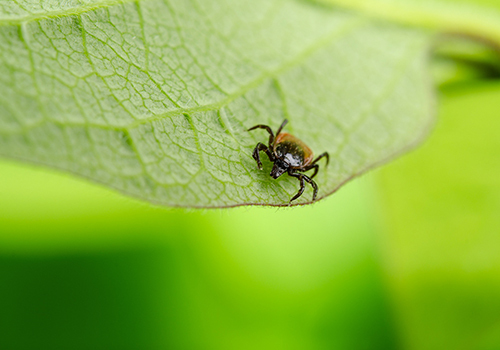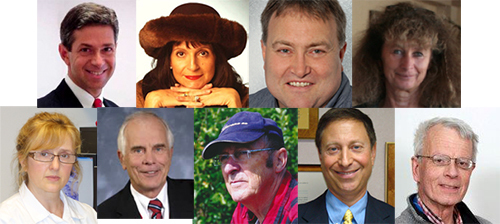
"The starting point for all research must be to look at the tick itself to understand which bacteria and viruses are in the ticks, especially in endemic areas. It's important we examine this because most patients suffer from multiple infections."
- Dr. Armin Schwarzbach
As renowned scientists and clinicians from all over the world head to the international Norvect Conference at the Grand Hotel in Oslo next Monday, there are important questions on the table, including: Why are a growing number of Lyme disease patients around the world unable to recover from their illness despite extensive antibiotics therapy?
There are two schools of thought regarding this question that continues to create conflicts in the science community to the detriment of progress and finding sustainable solutions. Vector-borne diseases are rapidly spreading across the globe. The Nordic countries are no exception. In Scandinavia, an increasing number of people are falling ill to diseases transmitted by ticks. The organizer of the NorVect Conference, Siw Hansson, hopes that contributors will be "open and curious about sharing knowledge. In this way, we will develop new insights and hopefully start to build bridges between the two frontiers."
To talk about the research urgently needed on the path to finding answers, I am delighted to be joined today in Part 18 of Ticks by some of the world-renowned participants contributing to NorVect: Dr. Ivar Mysterud, Dr. Carl-Morten Motzfeld Laane, Dr. Eva Sapi, Dr. Richard Horowitz, Dr. Joseph Burrascano, Dr. Armin Schwarzbach, Dr. Judith Miklossy, and Dr. Ed Breitschwerdt.
The research of Dr. Ivar Mysterud and Dr. Carl-Morten Motzfeld Laane was originally featured in Part 7 of Ticks.
Ivar and Morten - I understand the Norwegian Institute of Public Health is interested in investigating your unique diagnostic technique further. Can you please comment on this?
Ivar Mysterud/Carl-Morten Laane: Recently, we were invited by the National Institute of Public Health in Oslo (the NIPH) to join into a new project, which is a repetition of our initial project but on a somewhat larger scale. We will contact 20 long-term diseased people after castor tick bite, and NIPH will contact 40 healthy individuals as controls. We will do the microscopy of all their blood samples, and NIPH will implement all the DNA/PCR-tests on Borrelia and Babesia. Four different institutions are involved in this analysis. In other words, NIPH confirm they want to test our method.

"All commercial Borrelia diagnostic tests are based on one or two laboratory strains and therefore their sensitivity is poor. If these tests were based on clinical specimens then we would not miss as many cases." - Dr. Joseph Burrascano
Eva, Richard, Joe, Armin, Judith, Ed - If all the funding desired were available, how would you prioritize tick borne disease research, i.e. what areas of study must be further pursued in the challenge to find solutions for tick-borne illnesses, and why?
Eva Sapi: We need to fully understand why a lot of Lyme disease patients are not able to recover from their illness despite extensive antibiotics therapy. We need to better understand the different defense mechanisms of Borrelia and develop therapeutic strategies to combat them. We also need to evaluate how the various co-infections can contribute to chronic Lyme disease.
Richard Horowitz: Tick-borne diseases are rapidly spreading, and research monies must be used to regularly test ticks in different regions for changing patterns of infection. Malaria-like organisms like Babesia microti and Babesia WA-1/duncani, other borrelia species like Borrelia miyamotoi, and viral infections like Powassan encephalitis are now rapidly emerging throughout the United States. We need more accurate and earlier detection methods with better treatment strategies, since these co-infections are often implicated in persistent illness. Broader and targeted vaccination strategies against borrelia and associated co-infections would help to prevent transmission. Research should also be focused on the end stage effects of these infections. Lyme and associated co-infections affect the terrain of the body, causing hormonal imbalances and inflammation that damages our cells, tissues and nervous system. These have not been accounted for in double blind studies. Patients are also coming in to my office with environmental toxins like mold, and heavy metals like mercury, unable to clear neurotoxins from their body. Once these problems are addressed, many patients improve. Research therefore needs to be broadened to look at the multifactorial causes of chronic illness, since Lyme disease, Alzheimer's disease, autism and cancer are affecting millions of individuals, and medicine is searching for answers.

"Lyme and associated co-infections affect the terrain of the body, causing hormonal imbalances and inflammation that damages our cells, tissues and nervous system. These have not been accounted for in double blind studies." - Dr. Richard Horowitz
Joe Burrascano: Borrelia comprise a vast and diverse number of different species and strains, and each may result in differing clinical presentations and respond differently to treatment. All commercial Borrelia diagnostic tests are based on one or two laboratory strains and therefore their sensitivity is poor. If these tests were based on clinical specimens then we would not miss as many cases. I would attempt to culture Borrelia from as many patients as possible and then analyze these Borrelia. The hope is to create better diagnostic tests for clinicians.
Then I would do large-scale clinical studies to demonstrate the best ways to approach treatment. Hopefully, by knowing which specific Borrelia is infecting an individual, a specific treatment plan can be implemented.
Next, because a longstanding Borrelia infection can result in a lot of corollary damage, a clinical roadmap needs to be created to aid in diagnosing and correcting this damage. Finally, the results of these studies need to be published in medical journals, medical textbooks, given in continuing education and recertification courses for clinicians, and taught in all medical schools.
Armin Schwarzbach: The starting point for all research must be to look at the tick itself to understand which bacteria and viruses are in the ticks, especially in endemic areas. It's important we examine this because most patients suffer from multiple infections. I am convinced that human pathogens in the ticks are not just Borrelia burgdorferi, Rickettsia, Bartonella, Babesia and Ehrlichia/Anaplasma. Joe Burrascano did clinical definition by the symptoms of patients' "Bartonella like organism," which is not a clear microbiological definition of the right bacterial name and subspecies. But this example shows that it is most important to clarify the bacterial and/or viral "enemies" in the ticks to do the right science, develop the right specific diagnostic tests and create the right specific therapies. For example, Chlamydia pneumoniae and Chlamydia trachomatis were found in ticks. So first we should look at the pathogens in the ticks by improved PCR. Then, if we have classified the pathogens or combination of pathogens in the ticks, science should develop in vitro models with the different pathogens. For example, the macrophages play a very important role in in vitro models to understand more about the protection mechanisms of pathogens outside the ticks (pleomorphic forms, biofilms, etc.). We need to understand how these pathogens can survive antibiotic "attacks". Then we have to develop in vivo models from this basic knowledge. For example, what would be the best antibiotic or maybe antiviral strategy to destroy the pathogens and to possibly develop modified antibiotics against intracellular pleomorphic forms? These models would result in clinical studies with patients to answer the question: are long-term antibiotics really necessary or are combination therapies more effective? It will be a long road, but we don't have any other alternatives in the fight against the "known unknowns."

"The development of new therapies beyond the antibiotics available now are urgently needed. We need therapies that are more efficient with fewer side effects."
- Dr. Judith Miklossy
Judith Miklossy: The development of new diagnostic tests and therapies are imperative and urgent for Lyme disease. Serological and other diagnostic tests which recognize new Borrelia species and their divers subtypes involved in human Lyme borreliosis are also strongly needed to accurately diagnose Lyme disease. Additionally, the development of new therapies beyond the antibiotics available now are urgently needed. We need therapies that are more efficient with fewer side effects.
With respect to the causal relationship between Alzheimer's disease and various spirochetal infections, including Borrelia burgdorferi and several periodontal pathogen spirochetes, the development of an experimental animal model is critical in order to analyze the cellular and molecular mechanisms involved in spirochete-induced dementia. This experimental model would also be important to study new diagnostic tests and therapies for Lyme disease and Alzheimer's disease.
Ed Breitschwerdt: Bartonellosis is a zoonotic infectious disease of worldwide distribution, caused by an expanding number of recently discovered Bartonella species. The field of Bartonella research remains in its infancy and is rich in questions for which patient-relevant answers are badly needed. High priorities for our research include: 1) developing more sensitive serological and molecular diagnostic assays, 2) further efforts to define optimal Bartonella culture conditions, 3) characterization of virulence factors, 4) elucidation of the mechanism(s) leading to disease manifestations, 5) conducting prospective case-controlled clinical studies involving vascular, rheumatologic and neurologic diseases, 6) determining whether antibiotic resistance or other factors contribute to treatment failures, 7) developing safe and efficacious vaccines to prevent infection in pets and thereby prevent infection in people. It is possible that directed Bartonella research could substantially reduce animal and human suffering associated with chronic debilitating disease processes.

L to R Top Row: Joseph Burrascano, C. M. Rubin,
Armin Schwarzbach, Judith Miklossy
L to R Bottom Row: Eva Sapi, Edward Breitschwerdt,
Ivar Mysterud, Richard Horowitz, Carl-Morten Motzfeld Laane
For more information on the Norvect conference: http://norvect.no/conference-2014/
(All photos are courtesy of Norvect)
More on The Ticks Series: http://www.cmrubinworld.com/category/tickbornediseases/
In The Global Search for Education, join me and globally renowned thought leaders including Sir Michael Barber (UK), Dr. Michael Block (U.S.), Dr. Leon Botstein (U.S.), Professor Clay Christensen (U.S.), Dr. Linda Darling-Hammond (U.S.), Dr. Madhav Chavan (India), Professor Michael Fullan (Canada), Professor Howard Gardner (U.S.), Professor Andy Hargreaves (U.S.), Professor Yvonne Hellman (The Netherlands), Professor Kristin Helstad (Norway), Jean Hendrickson (U.S.), Professor Rose Hipkins (New Zealand), Professor Cornelia Hoogland (Canada), Honourable Jeff Johnson (Canada), Mme. Chantal Kaufmann (Belgium), Dr. Eija Kauppinen (Finland), State Secretary Tapio Kosunen (Finland), Professor Dominique Lafontaine (Belgium), Professor Hugh Lauder (UK), Professor Ben Levin (Canada), Lord Ken Macdonald (UK), Professor Barry McGaw (Australia), Shiv Nadar (India), Professor R. Natarajan (India), Dr. Pak Tee Ng (Singapore), Dr. Denise Pope (US), Sridhar Rajagopalan (India), Dr. Diane Ravitch (U.S.), Richard Wilson Riley (U.S.), Sir Ken Robinson (UK), Professor Pasi Sahlberg (Finland), Professor Manabu Sato (Japan), Andreas Schleicher (PISA, OECD), Dr. Anthony Seldon (UK), Dr. David Shaffer (U.S.), Dr. Kirsten Sivesind (Norway), Chancellor Stephen Spahn (U.S.), Yves Theze (Lycee Francais U.S.), Professor Charles Ungerleider (Canada), Professor Tony Wagner (U.S.), Sir David Watson (UK), Professor Dylan Wiliam (UK), Dr. Mark Wormald (UK), Professor Theo Wubbels (The Netherlands), Professor Michael Young (UK), and Professor Minxuan Zhang (China) as they explore the big picture education questions that all nations face today.
The Global Search for Education Community Page
C. M. Rubin is the author of two widely read online series for which she received a 2011 Upton Sinclair award, "The Global Search for Education" and "How Will We Read?" She is also the author of three bestselling books, including The Real Alice in Wonderland, is the publisher of CMRubinWorld, and is a Disruptor Foundation Fellow.
